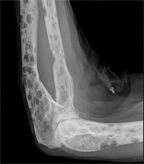ASCO: Daratumumab Safe in Multiple Myeloma
Results from a first-in-human trial of daratumumab indicate that the investigational drug reduced paraprotein and bone marrow plasma cells at doses greater than 4 mg/kg in patients with advanced multiple myeloma.
Results from a first-in-human trial of daratumumab indicate that the investigational drug reduced paraprotein and bone marrow plasma cells at doses greater than 4 mg/kg in patients with advanced multiple myeloma, according to data presented by Henk Lokhorst, MD, PhD, of the University Medical Center Utrecht, Netherlands, at the annual meeting of the American Society of Clinical Oncology (ASCO).

Multiple myeloma, x-ray with multiple osteolytic lesions in the forearm; source: Hellerhoff, Wikimedia Commons
Given this result, in addition to high response rates, the abstract discussant Saad Zafar Usmani, MD, FACP, of the Myeloma Institute for Research and Therapy at the University of Arkansas for Medical Sciences, said that he is certainly encouraged by daratumumab and expects that the drug will make it to the upfront setting.
Daratumumab is a fully humanized CD38 monoclonal antibody with a broad-spectrum killing activity. Dr. Lokhorst presented data on safety and efficacy from 32 patients enrolled in the dose-escalation part of the trial, and preliminary safety information from an expansion cohort.
The primary objective of the study was to determine the safety profile of daratumumab. Secondary objectives included establishing a pharmacokinetic profile and the evaluation of efficacy and immunogenicity.
In the dose-escalation portion, patients underwent eight weekly intravenous infusions using a 3+3 design, with doses increasing from 0.005 mg/kg to 24 mg/kg.
All patients had advanced multiple myeloma and had received at least two prior lines of therapy. Patients were classified as having an ECOG performance status of 0 to 2 and had a life expectancy of 3 months or longer. All patients were heavily pretreated, with many having already received bortezomib and lenalidomide; the majority of patients were refractory to both.
Plasma concentration analyses showed plasma peak levels as expected, but relatively rapid clearance at low-dose levels. However, at doses 4 mg/kg or greater, the observed PK values approximated model-predicted values, Dr. Lokhorst said.
To examine change in paraprotein, the researchers measured serum M protein. If that was not available, they measured the urine M protein and, if that was not available, they measured free light chains.
“Most paraprotein reductions were seen in the high-dosage groups, but even in patients with very low doses of daratumumab, stable or mild responses were observed,” Dr. Lokhorst said while discussing a waterfall plot of the results. Overall, 47% of patients who were heavily pretreated had a reduction in paraprotein.
These reductions in paraprotein resulted in clinical responses in 31% of all patients, including minimal responses and partial responses. Of those patients receiving 4 mg/kg or greater, 67% had a clinical response, including 75% of patients who were double refractory.
The progression-free survival has not yet been reached for patients who received doses from 4 mg/kg to 24 mg/kg. However, Dr. Lokhorst added that he has one patient at 40 months who is still in partial remission after receiving daratumumab.
The majority of severe adverse events reported were infusion-related. According to Dr. Lokhorst, most infusion-related reactions occurred early, during the first full infusion; few occurred later. Overall, 44% of patients had an infusion-related event grade 1–3. In addition, six severe adverse events were reported, including two patients who had bronchospasm.
Dr. Lokhorst and colleagues are currently exploring an 8 mg/kg weekly schedule in an expansion trial, but they will also be exploring higher doses and different schedules.
As the study moves forward to its expansion stage, Dr. Usmani said that it would be helpful to see information on standard vs poor prognostic clinical or biologic features.
Navigating AE Management for Cellular Therapy Across Hematologic Cancers
A panel of clinical pharmacists discussed strategies for mitigating toxicities across different multiple myeloma, lymphoma, and leukemia populations.